|
|
|
|
 |
Email Address Recovery or Password Reset |
Use our Change Password page, and you can set a new password, or if you don't remember which email address you
registered with, the same page may be able to suggest it based on another you enter.
|
|
|
|
|
| |
Flasks of
Encyclia boothiana 'Elizabeth' -spontaneous |
|
| |
|
|
| |
|
|
Click to Enlarge

Pod Parent Plant |
Click to Enlarge

Pod Parent Flower |
|
|
|
| |
Culture Notes from Donor: Parent plant: Temperature range W (70-90°F)
Comments: Parent plant: Miniature.
For additional origin/habitat information supplied courtesy of
Charles and Margaret Baker, see further below, near the bottom of this page.
|
Temperatures we attempt to use in the lab & greenhouse:
| For Species: |
|
Spring, Summer, Autumn, Winter: days average 90°F, nights 71°F; best fit is Warm 90-70°F
(Source:
Baker's Web OSC) |
|
About the name...
| Etymology of |
boothiana |
|
Named for William B. Booth, English gardener who provided plant material for the botanist Lindley.
(Source:
Mayr & Schmucker 1998) |
| Etymology of |
Encyclia |
|
From Greek "enkyklein" to surround, in reference to the lip enclosing the column.
(Source:
Pridgeon 1992) |
| Pronunciation of |
boothiana |
|
booth-ee-AH-na
(Source:
Hawkes 1978) |
| Pronunciation of |
Encyclia |
|
en-SIK-lee-ah
(Source:
Pridgeon 1992) |
|
If you would like to direct someone to this web page, please copy and paste this URL into your email:
http://troymeyers.com/d?014490
| Flask Information |
| Availability: |
We have sold all of the flasks for this item. |
| You should: |
Consider getting individual plants or compots instead of a flask.
You can place a "Notify Flask Recipients" Request, and either we or a flask recipient may contact you when plants are available.
You may also place a "Notify Retries" Request, and if an identical pollination (the same parents) is done again, we'll let you know.
You may reserve a flask, but it's very unlikely you'll get one ...this could only happen if we found a flask that we didn't know we had. |
| Yield Estimate: |
410 plants (based on flask surveys done 11/05/2004 through 09/14/2005)
|
| Plantlet Sizes: |
From many flasks 1 - 80 mm plants (based on flask surveys done 08/11/2004 through 02/07/2006)
From one most recently surveyed flask 30 - 80 mm (02/07/2006)
|
|
You might also want to:
|
View the seed assay for this item.
View items of the same species.
View items of the same genus.
|
| Ordering Information |
| You are not currently logged in. |
|
You must be a registered user and be logged in to reserve a flask or place a notification request. Please log in:
|
|
 |
Email Address Recovery or Password Reset |
Use our Change Password page, and you can set a new password, or if you don't remember which email address you
registered with, the same page may be able to suggest it based on another you enter.
|
|
|
|
|
|
|
|
| |
The origin/habitat information below is supplied courtesy of Charles and Margaret Baker
The following information is based on the name of the plant provided by the donor, and assumes that the name is correct. If the plant has been misidentified, then the following information may not be correct.
This text is copyrighted by the Bakers and may not be reproduced without permission.
ORIGIN/HABITAT: Cuba, Beilze, and Mexico. In Belize, plants are found in
the Orange Walk, Belize, and Cayo Districts where they grow in rather dry
forest and shrub below 350 ft. (100 m). In Mexico, plants are found in the
states of Campeche, Quintana Roo and Yucatán where they grow in dry scrub
forest and tropical deciduous forest from near sea level to about 500 ft.
(150 m). We were unable to find details of habitat location and elevation
in Cuba.
The plants reported as occurring in Florida in earlier literature were
described as Encyclia boothiana (Lindley) Dressler var. erythronioides
(Small) Lure, which was later considered a synonym of Encyclia boothiana
(Lindley) Dressley subsp. erythronioides (Small) Hágsater ex Christenson
and are now considered synonymous with Prosthechea boothiana (Lindley)
Higgins. These plants were first discovered on Key Largo, but before
development destroyed its habitat, it was said to be a relatively common
epiphyte in the hammocks of Dade and Monroe Counties. Luer (1972) reported
that although they are now greatly depleted in numbers, "they can still be
found in a few mosquito-infested swamps from Key Largo to Cape Sable.
More about this information and the Bakers...
|
|
|
| |
|
|
|